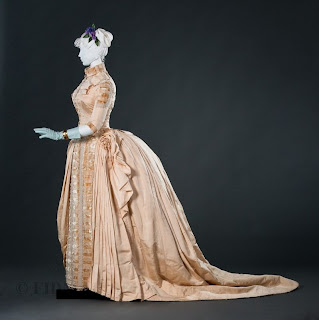Susan reporting:
E-books may be the unstoppable wave of the future, but for me there's still nothing like a great, big, heavy, luscious art book full of beautiful images beautifully printed, with thoughtful commentary to match. If the subject is historical dress and fashion, then I'm truly wallowing in visual heaven.
Fashion from the Kyoto Costume Institute, the Victoria & Albert's
Fashion in Detail series
, and last year's
Fashioning Fashion from the Los Angeles County Museum of Art, all have perpetual front-of-the-shelf status in my library. Now I have a new favorite to add to the collection: the aptly named
FABULOUS!, from the Fashion Institute of Design & Merchandising Museum in Los Angeles, CA.
As the subtitle says, the book catalogues the very best of the museum's acquisitions over the last ten years. Included are women's, men's, and children's clothing from 1800 to the present, from a diaphanous Regency gown to the amazing black lace dress by Alexander McQueen featured on the book's cover,
below. The1880s reception gown,
above left, shows not only an example of extravagantly bustled fashion, but also how clothes can become almost sculptural in their beauty. The pieces are photographed to display their style and craftsmanship, with many full-page close-ups for details of embroidery, lace, and fabrics. One of my favorite dresses is a gorgeously elaborate court gown and train from 1907, worn to an Edwardian royal reception at Buckingham Palace. Pages fold out of the book to be able to display the spreading train to full advantage, and best of all is a vintage photograph of the dress being worn by the original owner.
There's also a tasty selection of accessories, including hats, gloves, corsets, and shoes. Oh, the shoes! Surely this pair,
right, must have been worn to only the most exclusive of jet-set parties. Created by Roger Vivier for Christian Dior in 1959, they're leather, covered heel to toe in kingfisher feathers.
This is, in short, a wonderful book to explore and to treasure, with over 350 pages and 292 photographs and illustrations as well as fascinating commentary - a definite keeper for any true Nerdy History Girl. Even if you don't buy the book, check out the Museum's
blog. It's one of the best historic fashion blogs on the internet.
FABULOUS! Ten Years of FIDM Museum Acquisitions, 200-2010, by Kevin L. Jones, Christina M. Johnson, and Brian E. Sanderson, FIDM Museum Press, 2011.
Top left: Reception Gown, Europe or United States, c. 1886-1887
Right: Evening Shoes, by Roger Vivier for Christian Dior, Paris, France, 1959
In accordance with some FTC rule or another (which probably doesn't apply to us since we're writers, not reviewers, but never mind), Loretta and I received copies of this book as a gift from the museum.

























 One of us --
One of us -- 


